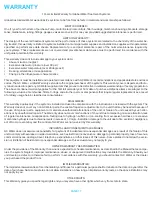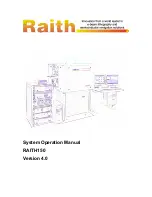
Follow each step to complete the start up:
1. First, verify all the plumbing connections are correct.
2. Verify that the “Delivery Pump” switch (5 in “Formulation System Diagram” on page 4) and the “Formulation” switch (6
in “Formulation System Diagram” on page 4) are in the off position.
3.
Verify the filters are fully seated and locked into the housings.
4. Verify that the bypass on the RO unit (Location located in the processing unit diagram) and the formulation unit (1 in
“Formulation System Diagram” on page 4) are turned off.
5. Turn on the city water that is feeding the unit. Check for any leaks around or within the unit.
6. Plug the system into a outlet.
7. Check the incoming water pressure and make sure it is within 50 - 90 psi. If it is below you will need a booster pump to bring
the psi within the acceptable range. If it is above you will need a pressure regulator to bring the psi within the acceptable range.
8. Turn on the “Processing System” switch (7 in “Formulation System Diagram” on page 44). The water processing unit
should turn on and the outgoing pressure gauge should start to read pressure. It should read within 10 psi of the incoming
pressure gauge.
9.
Let the tank on the unit completely fill. It will take about 30-45 minutes to fill the tank completely.
10. Double check the A & B Formula box connections.
11. Turn on the “Delivery Pump” switch (5 in “Formulation System Diagram” on page 4). Pump should pressurize and the
system gauge should read around 60 psi.
12. Do not turn on formulation switch until tank is full. When tank is full turn on the “Formulation” switch (6 in “Formulation System
Diagram” on page 4). The TDS controller should turn on and the 2 peristaltic pumps should begin to spin.
13. Verify TDS controller set points to verify they are within your parameters. (“Change The TDS Controller Set Points” on page
10)
14. Wait 5-10 minutes allowing the system TDS level to equalize. TDS levels are equalized when your TDS controller (4 in
“Formulation System Diagram” on page 4) is reading your desired TDS range.
15. Start Up is complete.
START UP INSTRUCTIONS
PAGE 9



































